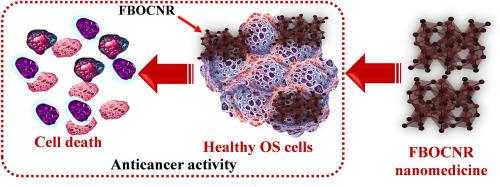Synthesis of bimetallic (Fe/Bi) oxychloride nanosheet-entangled rods (FBOCNR) for osteosarcoma nano-therapy
IF 4.7
3区 材料科学
Q2 MATERIALS SCIENCE, MULTIDISCIPLINARY
引用次数: 0
Abstract
Osteosarcoma (OS) is a bone cancer that is distinguished by osteoid and immature bone formation, having a high incidence rate in adolescents and children. OS is resistant to chemotherapy and less sensitive to radiotherapy, thereby making it challenging to treat OS. In this context, this study aims to produce Fe metals incorporated Bismuth oxychloride (BiOCl)-based nanosheets assembled rods (FBOCNR)-based nanomedicine for treating OS cells. The synthesized FBOCNR-based nanomedicine effectively destroys/kills OS cells, confirmed by MTT assay, structural analysis, fluorescence microscopy (acridine orange/ethidium bromide (AO/EtBr)), and expression of apoptotic genes. The MTT assay showed a dose-dependent cytotoxic effect of FBOCNR nanomedicine, with an IC50 of FBOCNR-0 (234.12 μg/mL), FBOCNR-0.5 (160.73 μg/mL), and FBOCNR-1 (185.15 μg/mL). Morphological analysis revealed apoptotic changes, including cell shrinkage, membrane blebbing, and reduced cell density. AO/EtBr staining confirmed increased apoptotic cell death in treated OS cells. Bright orange/red fluorescence indicated a greater fraction of apoptotic cells compared with that of controls. The FBOCNR-based nanomedicine downregulates Bcl2 and upregulates pro-apoptotic markers Bad, Bax, and caspase-3, enhancing programmed cell death. Therefore, the prepared FBOCNR-based nanomedicine provides newer possibilities for treating OS cells.

用于骨肉瘤纳米治疗的双金属(Fe/Bi)氯化氧纳米片缠绕棒(FBOCNR)的合成
骨肉瘤(Osteosarcoma, OS)是一种以类骨和未成熟骨形成为特征的骨癌,在青少年和儿童中发病率很高。OS对化疗有耐药性,对放疗不太敏感,因此对OS的治疗具有挑战性。在此背景下,本研究旨在制备含铁金属氧化氯化铋(BiOCl)纳米片组装棒(FBOCNR)纳米药物,用于治疗骨肉瘤细胞。MTT实验、结构分析、荧光显微镜(吖啶橙/溴化乙啶(AO/EtBr))和凋亡基因表达证实,合成的fbocnr纳米药物能有效破坏/杀死OS细胞。MTT实验显示FBOCNR纳米药物具有剂量依赖性的细胞毒作用,IC50分别为FBOCNR-0 (234.12 μg/mL)、FBOCNR-0.5 (160.73 μg/mL)和FBOCNR-1 (185.15 μg/mL)。形态学分析显示细胞凋亡改变,包括细胞收缩、膜起泡和细胞密度降低。AO/EtBr染色证实OS细胞凋亡增加。明亮的橙色/红色荧光表明,与对照组相比,凋亡细胞的比例更高。基于fbocnr的纳米药物下调Bcl2,上调促凋亡标志物Bad、Bax和caspase-3,增强程序性细胞死亡。因此,制备的基于fbocnr的纳米药物为治疗OS细胞提供了新的可能性。
本文章由计算机程序翻译,如有差异,请以英文原文为准。
求助全文
约1分钟内获得全文
求助全文
来源期刊

Materials Chemistry and Physics
工程技术-材料科学:综合
CiteScore
8.70
自引率
4.30%
发文量
1515
审稿时长
69 days
期刊介绍:
Materials Chemistry and Physics is devoted to short communications, full-length research papers and feature articles on interrelationships among structure, properties, processing and performance of materials. The Editors welcome manuscripts on thin films, surface and interface science, materials degradation and reliability, metallurgy, semiconductors and optoelectronic materials, fine ceramics, magnetics, superconductors, specialty polymers, nano-materials and composite materials.
 求助内容:
求助内容: 应助结果提醒方式:
应助结果提醒方式:


